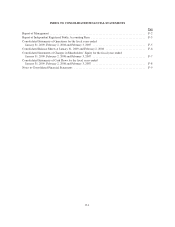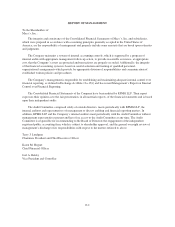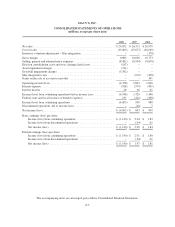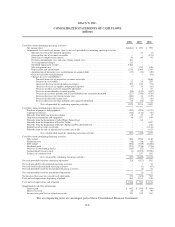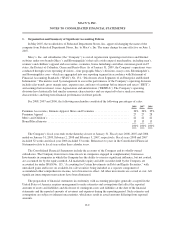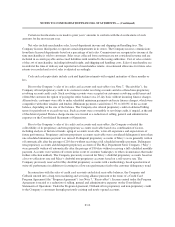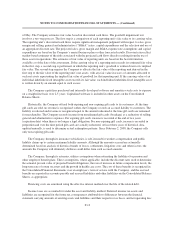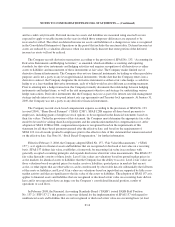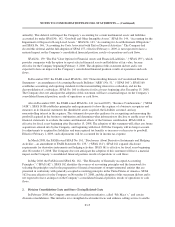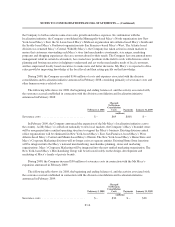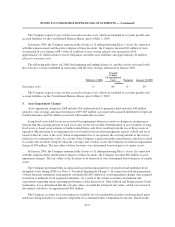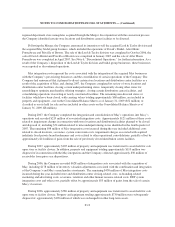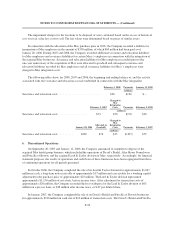Macy's 2008 Annual Report Download - page 58
Download and view the complete annual report
Please find page 58 of the 2008 Macy's annual report below. You can navigate through the pages in the report by either clicking on the pages listed below, or by using the keyword search tool below to find specific information within the annual report.
NOTES TO CONSOLIDATED FINANCIAL STATEMENTS — (Continued)
Certain reclassifications were made to prior years’ amounts to conform with the classifications of such
amounts for the most recent year.
Net sales include merchandise sales, leased department income and shipping and handling fees. The
Company licenses third parties to operate certain departments in its stores. The Company receives commissions
from these licensed departments based on a percentage of net sales. Commissions are recognized as income at the
time merchandise is sold to customers. Sales taxes collected from customers are not considered revenue and are
included in accounts payable and accrued liabilities until remitted to the taxing authorities. Cost of sales consists
of the cost of merchandise, including inbound freight, and shipping and handling costs. Sales of merchandise are
recorded at the time of delivery and reported net of merchandise returns. An estimated allowance for future sales
returns is recorded and cost of sales is adjusted accordingly.
Cash and cash equivalents include cash and liquid investments with original maturities of three months or
less.
Prior to the Company’s sales of its credit card accounts and receivables (see Note 7, “Receivables”), the
Company offered proprietary credit to its customers under revolving accounts and also offered non-proprietary
revolving account credit cards. Such revolving accounts were accepted on customary revolving credit terms and
offered the customer the option of paying the entire balance on a 25-day basis without incurring finance charges.
Alternatively, customers were able to make scheduled minimum payments and incur finance charges, which were
competitive with other retailers and lenders. Minimum payments varied from 2.5% to 100.0% of the account
balance, depending on the size of the balance. The Company also offered proprietary credit on deferred billing
terms for periods not to exceed one year. Such accounts were convertible to revolving credit, if unpaid, at the end
of the deferral period. Finance charge income was treated as a reduction of selling, general and administrative
expenses on the Consolidated Statements of Operations.
Prior to the Company’s sales of its credit card accounts and receivables, the Company evaluated the
collectibility of its proprietary and non-proprietary accounts receivable based on a combination of factors,
including analysis of historical trends, aging of accounts receivable, write-off experience and expectations of
future performance. Proprietary and non-proprietary accounts receivable were considered delinquent if more than
one scheduled minimum payment was missed. Delinquent proprietary accounts of Macy’s were generally written
off automatically after the passage of 210 days without receiving a full scheduled monthly payment. Delinquent
non-proprietary accounts and delinquent proprietary accounts of The May Department Store Company (“May”)
were generally written off automatically after the passage of 180 days without receiving a full scheduled monthly
payment. Accounts were written off sooner in the event of customer bankruptcy or other circumstances that made
further collection unlikely. The Company previously reserved for Macy’s doubtful proprietary accounts based on
a loss-to-collections rate and Macy’s doubtful non-proprietary accounts based on a roll-reserve rate. The
Company previously reserved for May doubtful proprietary accounts with a methodology based upon historical
write-off performance in addition to factoring in a flow rate performance tied to the customer delinquency trend.
In connection with the sales of credit card accounts and related receivable balances, the Company and
Citibank entered into a long-term marketing and servicing alliance pursuant to the terms of a Credit Card
Program Agreement (the “Program Agreement”) (see Note 7, “Receivables”). Income earned under the Program
Agreement is treated as a reduction of selling, general and administrative expenses on the Consolidated
Statements of Operations. Under the Program Agreement, Citibank offers proprietary and non-proprietary credit
to the Company’s customers through previously existing and newly opened accounts.
F-10



